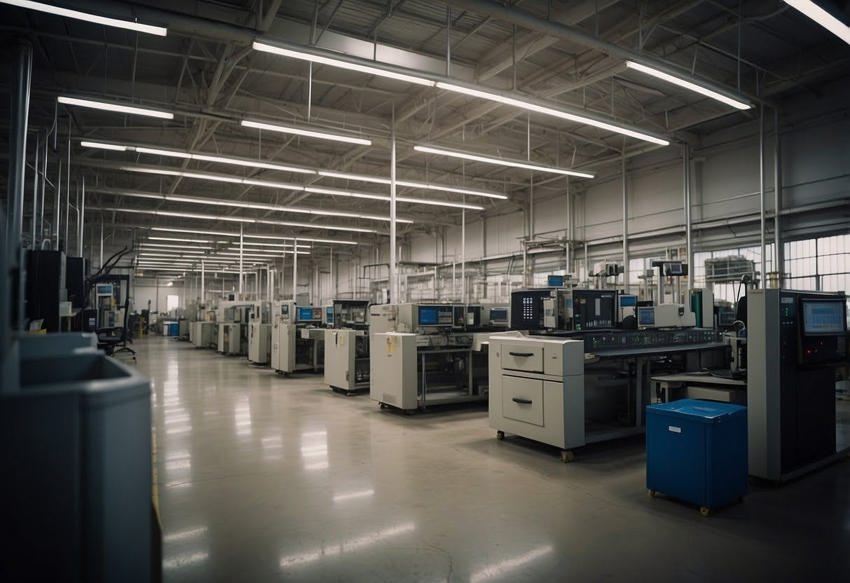What’s New in Business Central 2025 Release Wave 2
The Autumn brings the second major release of the year for Business Central, as part of the 2 wave annual update cycle. Here we look at the highlight features.
Effective production planning stands as a cornerstone of a successful manufacturing business. By strategically aligning resources, capacity and schedules, you can boost productivity, reduce costs and meet customer demands. By handling inventory valuations and liabilities efficiently, you create a solid foundation for your production process, minimising risks and maximising profit margins.

Understanding the nuances of inventory valuations helps your business maintain optimal stock levels. This ensures that you're not tying up valuable capital in unsold goods while also being ready to meet customer needs. Moreover, accounting for liabilities accurately protects your financial health and aligns with regulatory requirements, providing a safety net for unexpected challenges.
Incorporating effective production planning methodologies allows you to coordinate all aspects of your production process more effectively. This coordination leads to improved efficiency, reduced lead times and minimal downtime. Additionally, leveraging modern technology and best practices in production planning further enhances your ability to adapt and thrive in the competitive manufacturing landscape.
Effective production planning begins with a clear understanding of your manufacturing processes and managing your inventory efficiently. These foundations ensure you can meet demand and maintain optimal efficiency.

To ensure efficiency, you need a deep understanding of your production process. Each step must be scrutinised for potential improvements. This involves identifying bottlenecks, inefficient practices and opportunities for automation.
Production capacity refers to the maximum output your facility can achieve. Regularly assessing this is crucial. You must balance operating at full capacity without overworking resources.
Key actions:
By fine-tuning your production process and understanding your capacity, you can maintain a smooth operation. This ensures you meet customer demands consistently and efficiently.
Proper inventory management is essential. It involves tracking inventory levels to prevent shortages and overstock. Use metrics like average inventory value to gauge the effectiveness of your stock turnover.
Implementing inventory control systems helps manage resources wisely. Automated systems can provide real-time updates on stock levels, enhancing decision-making.
Key actions:
Effective inventory management minimises waste and reduces costs. By controlling inventory efficiently, you maintain optimal stock levels, ensuring your production processes are not disrupted.
In manufacturing, effective production planning and scheduling are vital to maintaining optimal inventory levels, reducing costs and ensuring timely delivery. This includes understanding various methods and adapting to real-time changes.
Discrete manufacturing involves producing distinct items in specific quantities, often requiring detailed scheduling to ensure parts are available when needed. Process manufacturing is continuous and relies heavily on precise timing to keep production running smoothly. Each type needs a different approach to scheduling.
In production scheduling, you utilise Gantt charts and Kanban systems. Gantt charts help map out the production timeline, making it easier to see what needs to be done and when. Kanban systems keep track of inventory levels and production needs in real-time, which can reduce waste and improve efficiency.
By using these tools, you can ensure that all necessary materials are on hand and that production steps are completed in the correct order. This minimises downtime and maximises efficiency, helping you meet production targets without unnecessary delays or costs.

Master production schedules (MPS) are essential for long-term planning, indicating what products need to be produced, in what quantities and when. An MPS takes into account demand forecasts, current inventory levels and production capacity. By maintaining a comprehensive MPS, you can avoid overproduction and stockouts.
Real-time data integration allows you to adjust your schedule based on current conditions. Technologies like IoT and big data analytics can dramatically enhance your processes. With IoT sensors and data analytics, you can track production stages instantly, making it easier to adapt to unexpected changes.
For instance, if a machine breaks down, real-time data can help you reroute tasks to minimise disruption. This adaptability ensures that your production process remains efficient and that you can meet delivery deadlines, even when unforeseen issues arise.
Implementing these methodologies enhances efficiency. You can provide a more reliable and cost-effective manufacturing process, ultimately fostering a stronger partnership with your clients.

Human resources play a crucial role in production planning. Effective management of human resources can significantly improve the performance and reliability of production systems. The skill level and availability of human resources directly influence the overall efficiency of production processes.
Proper allocation of your human resources ensures that the right people are in the right roles. This means identifying the skills and experience of your workforce and assigning them to tasks where they can excel.
Planning should involve a detailed analysis of each team member’s capabilities, matching their strengths to specific production needs. For instance, a worker with expertise in machinery should be utilised in areas requiring technical skills. This leads to increased productivity and reduced downtime.
To optimise human resources, consider using software tools that track performance metrics and manage shifts. Systems like Microsoft Dynamics 365 Business Central can integrate human resource management with production planning, facilitating better decision-making and resource allocation. Regular training programmes are also essential, ensuring staff can adapt to new technologies and production methods.
Human skill level significantly affects production efficiency. Higher skill levels lead to better problem-solving abilities, fewer errors and quicker task completion. Conversely, a lack of skilled workers can cause production delays and quality issues.
Ensuring resource availability is another critical aspect. This involves having a sufficient number of skilled workers available at all times. Overbooking or underbooking can both be problematic. Utilising tools for scheduling and forecasting can help manage resource availability effectively.
Incorporating human factors into production planning allows for a balanced workload, reducing stress on workers and improving job satisfaction. Monitoring and continually assessing the skill level and availability of your workforce will enable you to make adjustments as needed, enhancing the overall efficiency of your production processes.

Effective production planning requires managing both inventory valuations and liabilities. This involves accurately assessing inventory costs and risks and understanding regulatory requirements and financial implications.
Evaluating inventory costs is crucial for understanding your production expenses. Start by determining the direct costs, which include raw materials and labour. Indirect costs, such as storage and utilities, must also be considered. Knowing these costs helps you make informed decisions about pricing and discounts.
Managing risks is another key aspect. Stockouts and overstocking can lead to significant financial losses. Implementing robust risk management strategies can help mitigate these risks.
Regularly auditing your inventory ensures that discrepancies are quickly addressed. ERP systems like Dynamics 365 streamline this process, providing real-time inventory insights. By maintaining accurate records, you can better predict future demand and avoid unexpected expenses.
Complying with regulatory requirements is essential to avoid legal issues and financial penalties. Regulations can vary depending on the industry and location, but they generally cover areas such as safety standards, environmental guidelines and tax compliance.
It's important to stay updated on these regulations. Failing to comply can lead to hefty fines and damage to your reputation. Maintaining proper documentation and conducting regular audits can help ensure compliance.
Additionally, there are financial implications to consider. Mismanagement of inventory can affect your balance sheet, leading to inaccurate financial reporting. This makes it difficult to track liabilities and can impact your company’s financial health. Use inventory valuations to accurately assess the value of your stock, which aids in better financial planning.
By focusing on both regulatory requirements and financial implications, you can strengthen your production planning process and safeguard your business against liabilities.

Continued improvements in technology are transforming production planning, making it more efficient and responsive. Key technologies include production planning software, ERP systems and advanced scheduling tools.
Production planning software helps you manage and optimise your manufacturing processes. It provides tools to handle inventory, forecast demand and streamline operations.
ERP (enterprise resource planning) systems integrate various facets of manufacturing, such as procurement, production and sales. By connecting these areas, ERP systems offer real-time data and analytics. This lets you make more informed decisions. Dynamics 365 integrates both production planning software and ERP functionalities, providing robust features that allow manufacturers to manage every aspect of their business.
Implementing ERP systems can result in lower production costs and better inventory management. They also assist in aligning resources, capacities and schedules. You can link different areas of your production cycle seamlessly, ensuring that each department has what it needs to function effectively.
Advanced scheduling techniques help you optimise your production schedules. One approach is finite capacity scheduling, which considers the limitations of resources. This method helps to avoid bottlenecks and production delays.
Machine learning and big data analytics are increasingly used for production planning. These technologies analyse large sets of data to forecast demand and schedule tasks more efficiently. For example, smart production planning systems can adjust schedules in real-time based on current conditions.
The use of advanced tools lets you respond quickly to unexpected changes or disruptions. This flexibility is non-negotiable in today's fast-paced manufacturing environment. By incorporating technologies like IoT and cloud computing, you can enhance your overall production planning strategy, making it both more agile and efficient.

In this section, you'll find answers to important questions about inventory valuations, handling liabilities and effective production planning techniques in manufacturing.
Accurate inventory valuation provides a realistic view of your company's financial health. It directly affects the cost of goods sold and net income. With precise valuation, financial statements are reliable, aiding in better decision-making and adherence to compliance standards.
Effective production planning involves synchronising supply with demand, minimising excess inventory. Just-in-time production and demand forecasting are key strategies. They lower holding costs and reduce waste, ensuring resources are utilised efficiently.
Key components include accurate demand forecasting, efficient inventory management and robust scheduling systems. Integrating real-time data and adopting lean manufacturing principles enhances productivity and reduces waste.
Production planning and supply chain management work together to ensure timely delivery of raw materials and finished goods. By aligning production schedules with supply chain logistics, you can avoid delays, manage inventory levels, and boost overall efficiency.
Technology streamlines production planning through automated systems and real-time data analytics. Implementing ERP solutions, such as Microsoft Dynamics 365 Business Central, enhances inventory tracking, demand forecasting and resource allocation, leading to improved efficiency and reduced costs.
The Autumn brings the second major release of the year for Business Central, as part of the 2 wave annual update cycle. Here we look at the highlight features.
After a recent visit to the Digital Manufacturing 2day event in Coventry and an insightful presentation by Lord Chris Holmes, I thought I would delve a bit deeper into the current AI regulation facing UK industry.
Choosing the right ERP system when moving on from Sage 50 can shape how efficiently your business grows and adapts. If you want advanced features, greater flexibility and easier integration with familiar Microsoft tools, Microsoft Dynamics 365 Business Central is often the stronger option compared to Sage 200. As real-time data insight, automation and scalability are now necessities and not luxuries, your ERP upgrade decision is more important than ever.